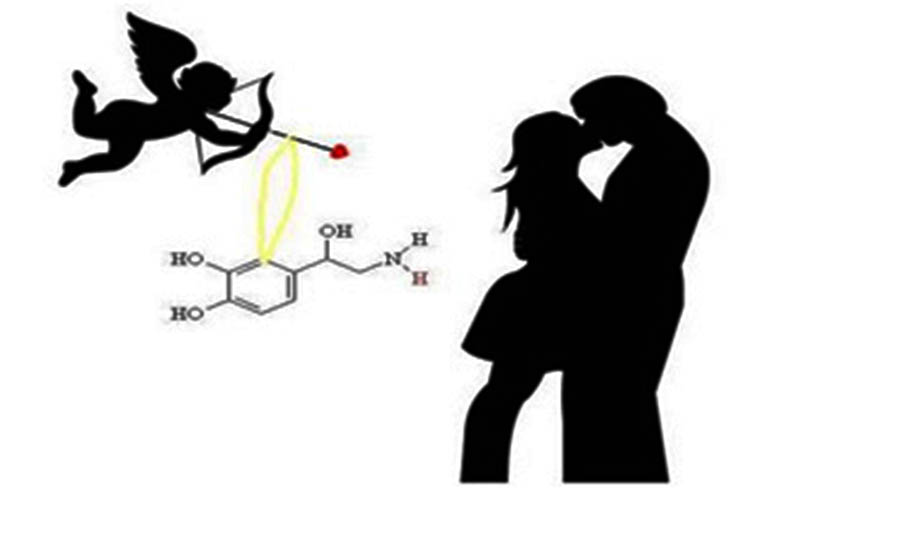Love has been sung by poets, painted by artists, celebrated by people. The idea of the existence of “special preparations”, with which anyone becomes irresistible (the “elixir of love”), runs through our imagination. Love surprises us when we least expect it and sometimes with those least expected.
Therefore, when the scientific hypothesis was put forward that humans are unconsciously influenced by a kind of secret perfume, the fragrance industry did not remain indifferent and investigated this matter.
Scientists then focused on the attraction between two people and it was in the performance of chemical signals that allow members of the same species to communicate at a distance that they found the key that allows opening some doors. And hearts too!
The glands spread across human skin produce secretions that give each person a distinct smell. These secretions are captured by those close to them, translating into a characteristic odor of the subject who is releasing them.
It was found that a person appreciates more the smell of someone who has a more differentiated genetic profile (DNA), a more distinct immune system (the greater this difference, the greater the resistance to a greater number of diseases).
This unconscious partner selection has a lot to do with the biological process of choosing the best pair for reproduction, usually the one that will confer “best genetic guarantees”.
There are those who call it destiny, but scientists attribute this “choice” precisely to these chemical substances (which they named pheromones), which stimulate one of the most common behaviors in Human Beings: sexual attraction.
The aroma of pheromones is detected at the level of the limbic system, increasing the passionate effect of dopamine in the brain (which acts as a sexual decoy).
And how does this attraction occur? In the initial phase, we are flooded with hope and anxiety, with the brain being bathed in stimulating substances such as phenylethylamine, serotonin, dopamine, norepinephrine and adrenaline itself. These compounds are responsible for the excitement and euphoria of these moments, but they are also generators of great restlessness. That's why two people in love don't feel hungry and endure a sleepless night.
This euphoria really creates dependency, keeping the body in constant anxiety. To avoid this, the body processes a second secretion of substances, natural opiates. This is the case of endorphins, compounds that provide a feeling of peace and tranquility; from vasopressin, the fidelity-related hormone; and oxytocin, responsible for the sensation of attachment and attachment. These molecules contribute to a lasting relationship that fosters a new family.
However, after the first few years, there is a decrease in substances and the body starts not receiving “its daily dose”. It's called the “Chemistry of Dislove”.
Evolution also has its share of responsibility in this process. Effectively, after passion (for the purpose of sexual interaction and procreation, for the continuity of the species), the chemicals that promote the stability of the relationship (attachment and fidelity) follow, responsible for maintaining this "bond" during the years immediately following the birth of the offspring.
However, Nature follows its “natural” course, and once the offspring are fit, it makes no sense to maintain this relationship. Therefore, the presence of these chemicals declines, leading parents to look for new relationships, crossing their genes with other partners. A kind of “guarantee of greater genetic diversity” and thus ensuring the continuity of the species…
Also in humans, one in three people is willing to end their relationship. There are those who say that this “chemistry of lack of love” is responsible for the “sadly famous 7-year crisis” that we've all heard about (regarding marriage).
Author Filipe Monteiro (Chemist, Science Communicator) – Filipe LS Monteiro was born in Belide, municipality of Condeixa-a-Nova, in January 1966, having graduated in Analytical Chemistry from the University of Aveiro since 1988.
He began his literary adventure in November 2011 with the release of his first children's book, “O Menino Who Dreamed to Save the World”, currently in its 8th edition.
This was followed, in January 2014, by the first novel, “O Segredo da Serra dos Candeeiros”, now in its 2nd edition, and a year later (January 2015) a new children's book, “Mestre Carbono, o Cientista”.
This book, currently in its 4th Edition, is part of the National Reading Plan, recommended for “Support to Scientific Projects and Themes” for the 3rd, 4th, 5th and 6th Years. In November 2017, he presented a new children's book, “The Toy that was Forgotten”.
Passionate about illusionism, he is a member of the two main associations in Portugal, the Clube Ilusionista Fenianos and the Associação Portuguesa de Ilusionismo, as well as integrating the Associação MagicValongo and the Grupo Mágico de Sintra, collaborating regularly in the promotion of this noble art.
Bringing together this facet of “magician” and “man of science”, he also produced a “Spectacle of Magical Science” that has captivated the audience that fills the rooms where it has been presented.
He also produced (for schools and science centers) “The Chemistry of Love”, a kind of lecture where he talks about the “chemical weapons” available to Cupid. All this always with magic in the background…
Accompanied by his wife, Maria José Alves, an integral part of all these projects, they have traveled the country performing sessions of great impact for always combining what they called “Science, Magic and Books: a perfect marriage!”.
More about the author at www.filipelsmonteiro.com/.





















Comments